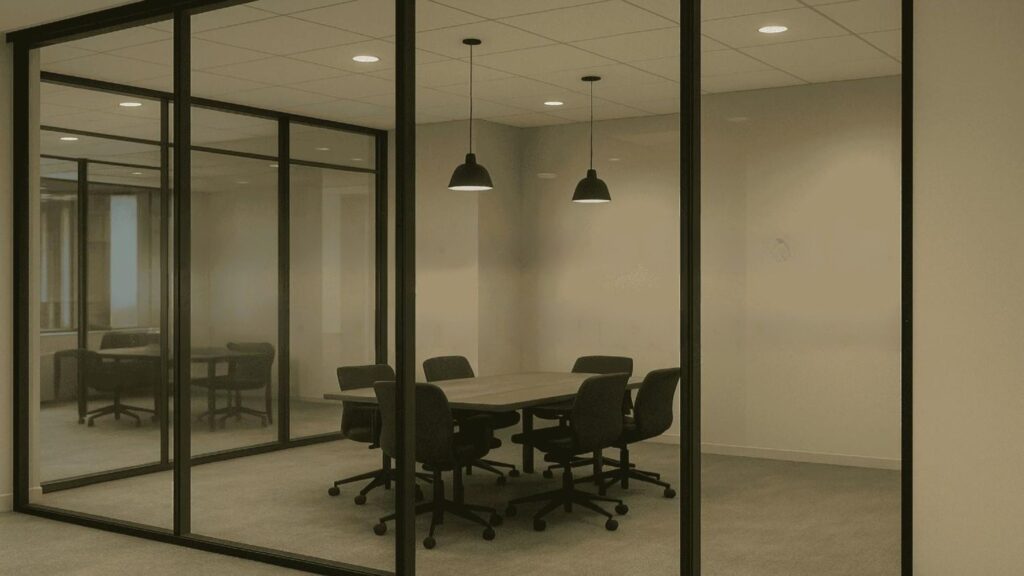Office spaces today are no longer just about desks and chairs. They are evolving to become smarter, more flexible, and more comfortable. With the rise of hybrid work, open-plan layouts, and a stronger focus on wellness, the way we design workspaces has changed drastically. One innovation leading this transformation is switchable glass.
Also known as smart glass or privacy glass, switchable glass can shift from transparent to opaque instantly, offering users control over privacy, light, and space usage. It is sleek, modern, and incredibly functional—making it a favorite among architects and interior designers.
Companies like Glasstronn are at the forefront of this smart glass revolution. Their cutting-edge solutions are helping businesses upgrade their office environments, making them more adaptable and future-ready.
Let’s explore how switchable glass is reshaping offices across industries and why it’s becoming a go-to solution for the modern workplace.
What is Switchable Glass?
Switchable glass is made with a special technology called PDLC (Polymer Dispersed Liquid Crystal). This allows the glass to change its appearance with a small electrical current. When powered on, the glass becomes clear. When powered off, it turns frosted or opaque.
This change happens in seconds and is controlled using a remote, switch, or smart system. It can be applied to doors, walls, partitions, windows, and more—anywhere traditional glass is used.
Why Offices Need Smarter Glass
Modern offices demand a balance of privacy and openness, functionality and style. Traditional walls and blinds often fall short. Curtains look outdated, and partitions block natural light. This is where switchable glass steps in, offering a solution that’s both practical and stylish.
Let’s look at the many ways this technology is transforming workspaces.
1. Privacy On-Demand
In an office, certain spaces need privacy—meeting rooms, executive cabins, HR departments, and more. Traditionally, this has meant installing blinds, curtains, or opaque partitions.
Switchable glass offers instant privacy with a single switch. When a meeting begins, just turn on the privacy mode and the glass becomes frosted. Once done, switch it back to transparent to maintain the open feel of the office.
This flexibility supports both confidential discussions and an open, collaborative vibe—without the need for extra hardware or space.
2. A Clean, Modern Look
Interior design plays a big role in shaping how people feel at work. Switchable glass fits right into modern minimalist office designs. It looks sleek and futuristic, with no need for bulky curtains or blinds.
Because it blends so easily into existing designs, it enhances the aesthetics of the space while keeping things professional and polished.
3. Better Use of Natural Light
Natural light boosts mood, reduces eye strain, and increases productivity. But getting enough daylight often means sacrificing privacy—especially in glass-walled rooms.
Switchable glass solves this problem. In its clear state, it allows maximum light to pass through. In privacy mode, it still diffuses light softly, keeping rooms bright without letting others see in.
This makes it ideal for open office designs where light and privacy both matter.
4. Flexible and Multi-Purpose Spaces
Many modern offices are shifting toward multi-functional areas—rooms that serve different purposes depending on the time of day or team needs.
For example, a large conference room might be used for presentations, interviews, or brainstorming sessions. Switchable glass lets teams change the room’s setup instantly. Turn on privacy for a confidential meeting. Turn it off when the space is open for general use.
This adaptability saves space and supports dynamic work styles.
5. Improved Communication and Collaboration
Switchable glass makes spaces feel open, connected, and inclusive. Transparent walls allow teams to see each other and feel part of a larger group, even when working in different rooms.
At the same time, the ability to switch to privacy mode helps cut out distractions during calls or focus work—striking a balance between collaboration and concentration.
6. Better Acoustic Control
While switchable glass doesn’t fully soundproof a room, it can reduce sound transmission when combined with acoustic glass or insulation. This makes it useful for rooms where quiet is important—like recording studios, HR offices, or client call rooms.
In larger spaces, it helps define zones and reduce overall noise, creating a calmer, more organized work environment.
7. Hygiene and Easy Maintenance
Unlike curtains or blinds, switchable glass is easy to clean and more hygienic. In a post-pandemic world, cleanliness in offices has become more important than ever.
The glass can be wiped down with a cloth and disinfectant, with no fabric to trap dust or bacteria. This makes it a smart choice for medical offices, labs, and shared workspaces.
8. Energy Efficiency and Sustainability
Some types of switchable glass also offer UV and solar control features. This helps block out heat during the summer, reducing the need for air conditioning and saving energy.
In winter, the insulation properties help retain heat, making buildings more energy-efficient. Over time, this leads to lower utility bills and a smaller carbon footprint—something every business can be proud of.
9. Enhanced Security
Switchable glass can improve security in several ways. When opaque, it prevents outsiders from seeing into sensitive areas like data rooms or finance departments. It also helps protect confidential information during meetings.
Additionally, in the event of glass breakage, the film layer can hold pieces together, reducing the chance of injury and adding a level of shatter resistance.
Real-Life Office Applications
Let’s look at some real-world office settings where switchable glass makes a difference.
a. Conference Rooms
Ideal for private discussions, presentations, and client meetings. Stay open to the office when not in use, and turn opaque when privacy is needed.
b. Executive Cabins
Maintain authority and openness at the same time. Clear glass keeps the space visually connected to the team; frosted glass provides discretion for confidential calls.
c. Reception Areas
Create a welcoming space that can transform when needed. Switchable glass adds a futuristic touch and can be used for dynamic branding and display screens too.
d. Partitions in Co-Working Spaces
Allow startups and freelancers to have personal zones that don’t feel boxed in. Switchable glass makes these areas flexible and responsive to different work modes.
e. Health and Wellness Rooms
Offices that include wellness or meditation rooms can use switchable glass to provide quiet and private environments when needed.
How It Works: The Basics of Installation
Installing switchable glass typically involves:
- Cleaning and preparing the glass surface
- Applying the smart film (for retrofit installations)
- Connecting to a power supply
- Setting up controls (switches, remotes, or smart systems)
It can be added to existing glass or included in new constructions. The system can also be integrated into automation platforms, so it can be scheduled or controlled remotely.
Why Designers and Architects Love It
Interior designers and architects favor switchable glass because it gives them more creative freedom. It removes the need for bulky blinds or rigid wall layouts, allowing spaces to evolve over time.
It also aligns perfectly with green building standards, smart office trends, and employee wellness initiatives—three things clients increasingly ask for.
Conclusion
In a world where flexibility, efficiency, and innovation matter more than ever, switchable glass is emerging as a game-changer in office design. It brings privacy without closing off space, enhances natural light, improves hygiene, and supports dynamic ways of working.
By transforming how we use glass in workspaces, it’s helping businesses create environments that are more inviting, productive, and future-ready.
As companies continue to evolve, Glasstronn remains a key player in bringing smart glass technology to the modern workplace. Their high-quality solutions and expert installations make it easier for offices to embrace this new standard in design.
Whether you’re renovating an old office or building a new one from scratch, consider switchable glass—and trust Glasstronn – India’s Trusted Switchable Glass Manufacturer to help you unlock the full potential of your workspace.





